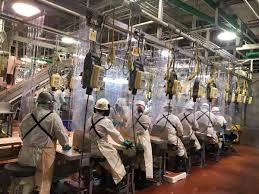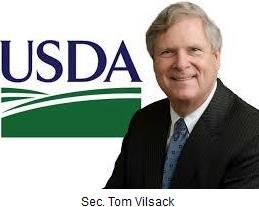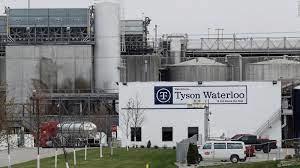 On June 1st, the USDA announced a program to “transform the food system”. The cost of the various initiatives will be $2,845 million. Although to the current Administration, that’s just one of a series of numbers in a universe of infinite spending of funds that has added to the national debt .
On June 1st, the USDA announced a program to “transform the food system”. The cost of the various initiatives will be $2,845 million. Although to the current Administration, that’s just one of a series of numbers in a universe of infinite spending of funds that has added to the national debt .
The objectives of the intended transformation will include:
- Avoiding supply chain disruptions such as occurred during the COVID crisis in 2020. This would be achieved through increasing the capacity of small packing plants and cold storage installations
- A reduction in the regional concentration of facilities.
- Creating a ‘fairer’ food system that avoids oligopoly in meat and poultry processing.
- Providing nutritious food to all consumers with an implied emphasis on lower income and minority demographics.
- Introducing equity with special reference to underserved and rural communities experiencing poverty.
The intended expenditure of close to $3 billion would be justifiable if the objectives were to be achieved and within a relatively short period. Even superficial evaluation of the program suggests that much of the allocation would be devoted to the social, environmental and rights agenda of the Administration using the USDA as a vehicle.
 Among the food production initiatives, the USDA intends investing $300 million in a new “organic transition”. Agricultural economists and agronomists consistently criticize organic production as being non-sustainable and providing little in the way of improved nutrition but at a high cost. Stocking shelves of boutique food stores with expensive produce will not contribute to any of the transitional aspirations of the framework.
Among the food production initiatives, the USDA intends investing $300 million in a new “organic transition”. Agricultural economists and agronomists consistently criticize organic production as being non-sustainable and providing little in the way of improved nutrition but at a high cost. Stocking shelves of boutique food stores with expensive produce will not contribute to any of the transitional aspirations of the framework.
USDA intends to spend $75 million to support ‘urban agriculture’. Studies have shown that turning vacant lots in inner cities into vegetable gardens does little to improve nutrition and the projects are financially non-viable. They do, however, make for good photo-ops for USDA administrators and politicians and certainly benefit local activists. If urban agriculture is an objective then high-tech capital intensive vertical farming should be considered. Anything less is moving bricks and scratching soil.
Independent meat and poultry processing plants will be collectively supported by grants totaling $375 million. Previously, CHICK-NEWS and EGG-NEWS have opined that sprinkling public money over many small projects does little to improve total meat supply. Free market forces drive the establishment of highly efficient and capital-intensive projects such as a proposed South Dakota plant, capable of processing 8,000 head per day. The capital investment of $1.1 billion will provide consumers with more meat at a cheaper price than 400 small plants processing 20 animals per day.
The USDA intends to provide $600 million in financial assistance to support the food chain infrastructure for other than meat and poultry. Investments will include cold storage, refrigerated vehicles and processing facilities. Why has the USDA elected to compete directly with companies that have already committed capital to facilities that presumably provide a return on investment? The fact that public-sector funding is required suggests financial non-viability.
A $400 million allocation will be used to create “regional food business centers”. The objective of this considerable sum is vague and conflicts with the activities of the Small Business Administration. Again, the USDA intends favoring “underserved communities” that will ultimately benefit local politicians without necessarily contributing to either more or cheaper food.
Some projects could alleviate existing problems providing they are designed, implemented and above all, monitored to ensure achievement of objectives. These include $60 million for the farm-to-school program, $90 million to prevent food loss and wastage, technical assistance and training and $100 million for the Healthy Food Incentive Fund, concentrating on school feeding.
 Despite questioning the motivation for the Administration intention to “transform the food system” and the mechanism selected, there is obvious concern over accountability. It will be necessary to monitor expenditure and above all, recognizing results through quantifying the return on investment attained by projects. Neither the previous nor the present Administrations can account for the vast sums expended to support the economy during the worst months of the COVID epidemic. Irrespective of which Administration occupies the White House, USDA has developed an advanced capacity to distribute money without necessarily being able to account for expenditures or to measure results.
Despite questioning the motivation for the Administration intention to “transform the food system” and the mechanism selected, there is obvious concern over accountability. It will be necessary to monitor expenditure and above all, recognizing results through quantifying the return on investment attained by projects. Neither the previous nor the present Administrations can account for the vast sums expended to support the economy during the worst months of the COVID epidemic. Irrespective of which Administration occupies the White House, USDA has developed an advanced capacity to distribute money without necessarily being able to account for expenditures or to measure results.
It is conceded that problems occurred during the COVID crisis. Concentration of production capacity among a few companies and a limited number of highly efficient plants allows for large-scale production and distribution. This approach carries the attendant risks of disruption by a common factor. In 2020 COVID infection among line workers became a serious limiting factor to output in the U.S and the E.U. Despite a sharp but transitory decline in red meat output, in the event preventive measures restored production even before the advent of a vaccine. This was achieved through the initiatives introduced by the major red meat and chicken companies with minimal input from the CDC and OSHA.
We should learn from the problems that occurred in 2020 and make appropriate improvements and changes that have and will continue to require investment. The USDA has a role to play in providing technological input but should not take on the responsibility of restructuring the meat industry. Attempts to create an alternative production system or breaking up the “Big Four” will be disruptive and contrary to the principles of free-enterprise.
Secretary Vilsack and his senior administrators should examine the effects of extreme social engineering on agriculture, including starvation in the Soviet Union caused by inappropriate collectivization; mass famine in China; the East African Groundnut debacle conceived and implemented by the post-World War II Labor Government of the U.K.; pre-Borlaug grain production in socialist India and the destruction of the vibrant chicken industry in Venezuela by idealistic and corrupt socialism.
Admittedly, we have problems, but these can be resolved using available resources. These include agricultural economists and agronomists in the Land Grant universities and the USDA and above all, contributions from competent managers and technicians in industry. The USDA should be promoting dialog and cooperation among stakeholders not trying to establish a new paradigm. The expedient of throwing money at presumed deficiencies and attempting to resolve long-standing problems will be expensive and ultimately unsuccessful. Attempts to correct economic policies that impacted disadvantaged groups will not be achieved during the transitory tenure of this Administration and its Department of Agriculture. Preserve us from the zealots, do-gooders and social engineers among the political appointees at the USDA. Unrestrained by Congress they will throw out the baby with the bathwater!